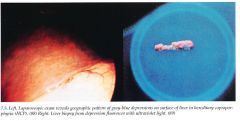![]()
![]()
![]()
Use LEFT and RIGHT arrow keys to navigate between flashcards;
Use UP and DOWN arrow keys to flip the card;
H to show hint;
A reads text to speech;
11 Cards in this Set
- Front
- Back

Clinical Hereditary Coproporphyria
|

|
|
|
Inheritance
|
Autosomal dominant; coproporphyrinogen (COPROGEN) oxidase gene on 3q12
|
|
|
Prenatal
|
DNA analysis
|
|
|
Incidence
|
Rare estimated 2 per million in Denmark; M=F; symptomatic M:F=1:2.5
|
|
|
Age at Presentation
|
Third to fourth decade of life
|
|
|
Pathogenesis
|
COPROGEN oxidase gene mutation causes the phenotype
Acute attacks precipitated by same factors as AIP and VP Increased ALA synthetase with attacks |
|
|
Clinical
|
Skin (approximately 30% of symptomatic patients)
Delayed photosensitivity changes similar to PCT and VP (see pp. 216, 218) Acute Attacks Central Nervous System Similar to AIP and VP Gastrointestinal Similar to AIP and VP |
|
|
DDx
|
AIP
VP PCT |
|
|
Lab
|
Plasma porphyrin level and fluorescence spectrum
Increased coproporphyrin levels in stool and urine Increased ALA and PBG in urine during attacks only |
|
|
Management
|
See AIP and VP
|
|
|
Prognosis
|
Acute attacks may be life threatening; many gene carriers are asymptornatic throughout life
|

